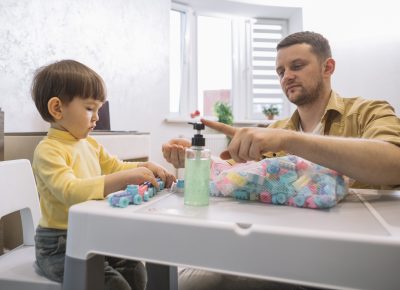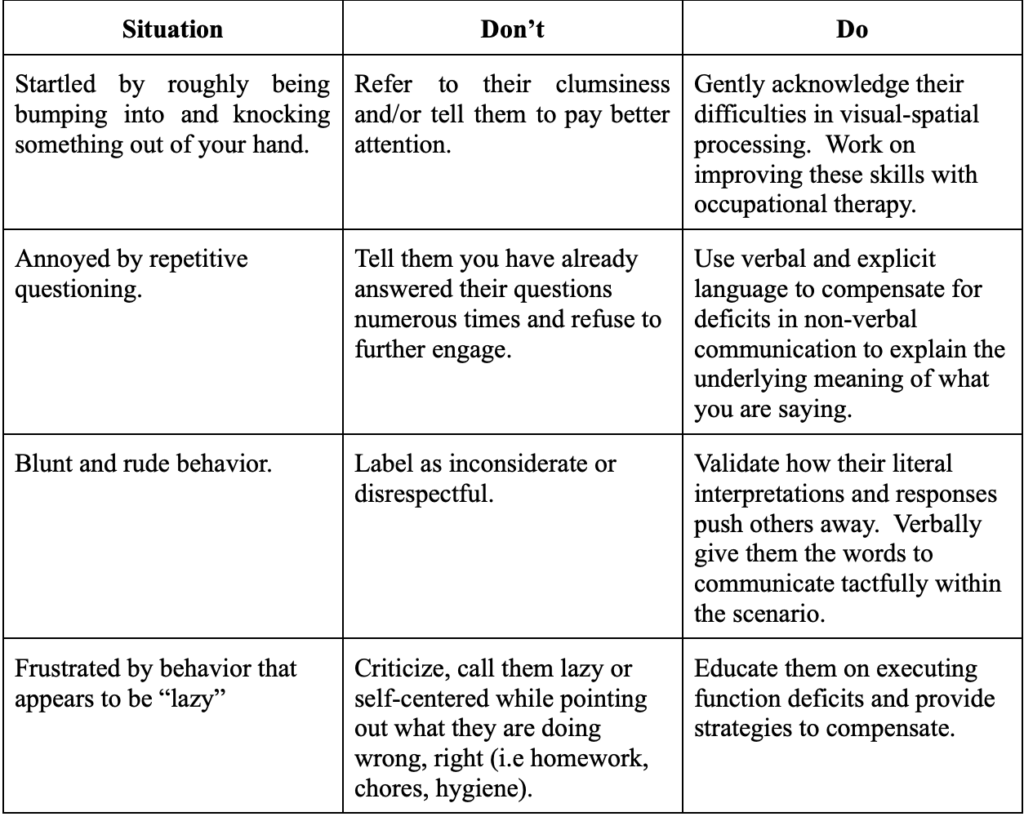Author Archives: addvantages
Giant in the Workplace, Tiny at Home

I do a stellar a job at work. It’s at home that I fall on my ADHD face. Here’s how I learned to do more chores without trying to become a domestic goddess.
Do you ever get a song stuck in your head that you can’t shake? The other day I saw a commercial for Green Giant vegetables, and I couldn’t get the jingle out of my brain. Over and over again, I caught myself thinking, humming, and singing “Ho, ho, ho, Green Giant.”
Instead of fighting it, I deliberately thought about green giants to trick my mind into thinking about something else. Somewhere in between my strategy and the racing thoughts of an adult with ADHD, I transitioned from giants to failing at growing a vegetable garden. It’s no secret to friends and family that I am a Betty Crocker-Donna Reed wannabe, with little success.
It made me wonder how I could be a competent business owner and founder of a learning center for kids and adults with ADHD and still be a hapless home diva who can’t put a meal together without burning it! I know I am not the only woman with ADHD facing this dilemma of running circles around others at work, but being unable to get the house clean or tackle dirty dishes and mind-numbing chores.
What I realized is that I am not comparing apples to apples. Work and home are different worlds. We are paid to perform at work and are held accountable for our actions. This increases our adrenaline levels. We must be prepared for the meeting, arrive on time, and so on. We are given immediate feedback and measured on our achievements, or lack thereof.
At home we are left to our own devices and in-and-out motivation. There is no structure to get our frontal lobes in gear to do boring tasks. The key to home success is to recreate an environment that simulates work. For example:
[Self-Test: ADHD Symptoms in Women and Girls]
Structure your day, hour by hour, slotting in things that need to get done.
- Hold yourself accountable by reporting to someone about what you have accomplished.
- Make deals with family members and trade off tasks that are harder for you to do. Realize that, for people with ADHD, it’s not trying harder but working smarter that is the key to success.
- Don’t compare yourself to others. Give yourself permission to do what is reasonable for you to accomplish and take shortcuts. Allow yourself to bake those prepackaged cut-and-slice cookies instead of making them from scratch! Accept that you are doing the best you can, despite having a brain that is not working up to full capacity. Would you expect a paralyzed person to walk?
- Give yourself a break and remind yourself that you have a neurobiological disorder. You may not be a domestic goddess, but you have other talents and positive attributes. As I say this to you, I reaffirm for myself that it’s OK to boil Green Giant frozen vegetables instead of harvesting them from my vegetable garden!
Say goodbye to Martha Stewart and embrace your ADDa Girl. You are an amazing, dynamic, determined woman with ADHD!
[“I Have ADHD? That Explains Everything!”]
 Linda Karanzalis, MS
Linda Karanzalis, MS
Linda Karanzalis, MS, is a former special education classroom teacher with over 25 years of experience in the areas of learning disabilities, ADHD, social-emotional learning, social skills training, and behavior management
I’m Not His Maid!

ADHD children need chores broken into manageable steps so they don’t feel overwhelmed by the tasks in front of them. Read these expert tips.
Children with ADHD need structure — lots of it. And that includes strategies to accomplish tasks that may seem ‘easy’ or ‘common sense’ to others.
Many children with ADHD often shut down when overwhelmed and may act out when confronted with meeting parental expectations, like cleaning their room, as they have no idea how to start and finish. By cleaning his room for him to avoid a meltdown, you are actually reinforcing and rewarding your child for inappropriate behaviors. Of course this is not your intention, but the cost of keeping the peace backfires in the long run. It is better to endure the short-term stress to teach your child life-long skills to manage himself and the expectations of others. This is how your child with ADHD becomes an independent adult.
Your child with ADHD can learn how to clean his room with consistent practice. First you need to define what ‘cleaning your room’ means. Break down the steps and put the list on a poster board that hangs in his room. Laminate the poster board so your child can use a wipe off marker after he completes each step. Practice with your child by showing him how to do for each item on the list.
[Free Download: Your 13-Step Guide to Raising a Child with ADHD]
For example, if you want him to put his clothes in the laundry, place two baskets in his room. He will put all the whites in the white basket and the darks in the dark basket. If you would like him to pick up his shoes place a plastic shoe holder that is hung over his bedroom door. Assess your child’s belongings and provide a home for each one.
One child I worked with loved baseball cards, he knew exactly where they were, strewn all over his bedroom floor! I worked with his mother to devise a system of placing them in plastic card holders and organizing them in binders by leagues, teams, Hall of Famers, and positions. The child was proud of ability to manage his cards as was his mother.
Break down each task and practice with your child until he masters each one independently, and the next time you say ‘clean your room’ your child will know exactly what to do!
 Linda Karanzalis, MS
Linda Karanzalis, MS
Linda Karanzalis, MS, is a former special education classroom teacher with over 25 years of experience in the areas of learning disabilities, ADHD, social-emotional learning, social skills training, and behavior management
Motivation for Children: How to Reward Behavior Without Technology

“The thing that motivates my 11-year-old son with attention deficit hyperactivity disorder (ADHD) is screen time — whether on the computer or watching TV,” one reader tells us. “He gets one hour a day during the week and two hours a day on the weekend. Unfortunately, it’s about the only thing that motivates him. I wish I could find something new.”
Children with attention deficit hyperactivity disorder (ADHD) crave stimulation and immediate feedback, feeding into the use of technology. Both kids with ADHD and their neurotypical peers need to spend less time on the computer and more time in the real world interacting and communicating with others. The amount of time you have allotted for screen time is good. However, your child needs to earn this time.
The good news is you can find additional activities for your child to enjoy that do not include the use of a computer. He may feel more comfortable on the computer than interacting with others. To work on changing this, give your child tools to succeed in interpersonal relationships by enrolling him in a social skills training class to learn how to make and keep friends.
Also work with your child to explore other sports and activities that are stimulating and engaging. Physical activity has been shown to increase focus and benefit those with ADHD. Some kids with ADHD struggle in team sports due to difficulty following directions and/or poor motor skills. If that’s the case for your child, encourage him to try running, working out at the gym, gymnastics, or martial arts like karate.
Many kids with ADHD are turned off by reading and often report how boring it is for them as a result of their inability to maintain focus. But one way to encourage reading is, ironically, through the use of technology. I have seen many children with ADHD become motivated to read for enjoyment using an e-reader such as a Kindle or Nook. Technology can be a viable tool when it is used to expand the mind and help bridge the gap between a child’s learning difficulties and his or her strengths.
 Linda Karanzalis, MS
Linda Karanzalis, MS
Linda Karanzalis, MS, is a former special education classroom teacher with over 25 years of experience in the areas of learning disabilities, ADHD, social-emotional learning, social skills training, and behavior management
Hygiene Help for Kids With Sensory and Attention Issues

“How can I get my child with ADHD to practice good hygiene independently — wash their hands, brush their teeth, comb their hair? What if they have sensory issues?”
Daily tasks with little to no stimulation are difficult to attend to for those with attention deficit hyperactivity disorder (ADHD) and even more so for those with sensory processing problems. During my years as a behavior and learning specialist, I have worked with countless children who have had a very difficult time with sensitivities to water pressure and temperature, brushing teeth, tangled hair, static cling, and more. With a little bit of creativity and practice, you can teach your child the importance of grooming.
[6 At-Home Occupational Therapy Techniques That Really Make a Difference]
Think in terms of, “How can I solve this problem?” You will be surprised how many ideas will pop up in your mind to make things easier for your child when you are in a problem-solving mode. Don’t forget to ask your child for input as she may come up with her own solutions with your assistance.
Try some of these strategies to decrease uncomfortable sensations, such as dry spray-on shampoo, face and body wipes, motorized toothbrushes, and shower heads with varying degrees of pressure. Take your child on a shopping trip to purchase stimulating and novel grooming tools to help wake up the brain and increase motivation, such as florescent combs and brushes, scented pump soap, toothpaste, and so on. Practice morning and bedtime grooming rituals on the weekend when you and your child are not trying to get out of the house on time and emotions are running high.
To educate your child on the importance of good grooming and hygiene, I recommend reading this article from LiveStrong.com and watching the videos below. I think you’ll be pleased with of the array of high-interest activities for both of you to enjoy!
 Linda Karanzalis, MS
Linda Karanzalis, MS
Linda Karanzalis, MS, is a former special education classroom teacher with over 25 years of experience in the areas of learning disabilities, ADHD, social-emotional learning, social skills training, and behavior management
Step Back from Symptoms and See Yourself Clearly to Rescue Faltering Friendships

Blurting, rudeness, and poor impulse control were sabotaging friendships for this woman with attention deficit. By stepping back and taking stock, she learned how she looked to others — and turned the trend around to improve her social skills.
A gal can get herself in a fix when the “I” part of ADHD rears its ugly head. When our impulse control is out of whack, and we don’t slam on the brakes as words careen from our brain to our mouth, things get problematic.
Lori, one of my coaching clients, was distraught by her inability to maintain friendships. She found herself alone a lot, despite her attempts to develop a few good companions. She didn’t have trouble making friends initially. She had problems keeping them.
When Lori spent time with people she liked, she spewed out unsolicited advice, dominated conversations, interrupted others’ conversations, and said one thing and did another. It wasn’t surprising, except to Lori, that people didn’t want to hang around with her. It wasn’t that people didn’t like her: She knew how to have fun and organized fun events at her house that filled up so fast that there was a waiting list to attend!
[“Why Don’t I Have Any Friends?”]
Steady, long-term friendships eluded her, though. Her “friends” found it exhausting to cope with her emotional intensity and social glitches. I worked with Lori on this. She learned that her ADHD symptoms interfered with her ability to recognize how she was coming off to friends and acquaintances. When she finally realized that her best impulses — love and kindness — were frequently eclipsed by less desirable ones, she started to turn things around.
One thing Lori had a lot of trouble with was sending off emotional e-mails before re-reading them. As soon as she clicked send, she usually regretted the word salad she had just tossed in someone else’s lap. To conquer this habit, Lori put a red dot on her mouse and used it as a visual cue to stop and think before clicking. These days Lori spends more time relaxing instead of doing damage control about things she said.
Best of all, Lori has made —and kept — several good friends.
If you learn anything from this blog, learn that you need to step back from your symptoms and see your behaviors from other people’s point of view. When you do that, you can create strategies that will help you reframe your words and deeds that will draw people to you.
[5 Ways ADHD Makes Me the Best, Rudest, Most Caring, Totally Frustrating Friend You’ll Ever Have]
 Linda Karanzalis, MS
Linda Karanzalis, MS
Linda Karanzalis, MS, is a former special education classroom teacher with over 25 years of experience in the areas of learning disabilities, ADHD, social-emotional learning, social skills training, and behavior management
“How Can I Make New Friends?”

“Right now my friends are 60 and older. It’s not all bad, but it does get lonely. Where can I meet friends my age? How can I form real connections?”
Friends come in all shapes, sizes, and ages. Older friends can offer guidance, provide valuable insights, and offer you opportunities to learn and grow from their experiences. So don’t discount these important friendships, and in the meantime find ways to connect with others in your age group.
The good news is social skills can be learned and you can forge friendships with your peers. First you need to understand how ADHD impacts your communication. Think of it like this: If you wear glasses and the lenses are foggy and scratched, what you see will be skewed or distorted. So too with ADHD — it makes it harder to decipher the signals from others (body language, tone of voice, facial expressions) and to appropriately respond. Ask your older friends and family to give you feedback on how you come across to others and practice refining the skills that need to be improved. Attend a CHADD meeting to meet other adults with ADHD. There is no need to be alone. Another way to meet others in your age group is by participating in activities focused on your interests; go to MeetUp.com for a list of groups in your area.
However, if you have never had a friend, you will need assistance from a coach or therapist experienced in social-skills training to help you identify your strengths and weaknesses and to create a plan to move forward.
 Linda Karanzalis, MS
Linda Karanzalis, MS
Linda Karanzalis, MS, is a former special education classroom teacher with over 25 years of experience in the areas of learning disabilities, ADHD, social-emotional learning, social skills training, and behavior management
ADHD-Friendly Schedule Fixes for Working Parents

“Help! I know children with ADHD need consistent schedules, but what can working parents or parents with inconsistent schedules do to help their kids?”
Being consistent with schedules, instructions, and discipline as parents to children with attention deficit hyperactivity disorder (ADHD) is hard enough for parents who work regular hours, so I understand your dilemma, but hopefully my experiences as an adult with ADHD and as a special education teacher and ADHD coach will help.
Just because your schedule is inconsistent doesn’t mean the basic structure that children with ADHD need on a daily basis has to be. If you can incorporate the following routine-builders — even at varying hours of the day or with help from a partner or another adult caregiver — your child will benefit.
Because children sometimes have the comorbid condition of sensory processing disorder, I recommend that you set up a scheduling system based on visual and tactile input. If you have children without ADHD, they will benefit as well. Putting everyone on the same system creates a smoothly running household, and your child with ADHD will be more likely to participate if he doesn’t feel singled out.
The scheduling system can be tailored to the age and needs of each child. To be effective, it needs to be simple so that you can actually maintain the schedule along with other aspects of your hectic home life.
How to create a visual, tactile system to structure your child’s daily schedule.
- Decide on the activities you would like your child to do on a daily basis. Start with getting up in the morning and end with bedtime. Be sure to break down each task.
[Free Resource: Routines for Morning and Night]
- Adjust activities to the age of your child. Remember, even if your child is older, children with ADHD are usually three years behind in maturity in scattered areas when compared to their peers.
- Take photos or find pictures online to represent what your child needs to do. Find a photo of a bed for when your child should make his or use a drawing of a toothbrush to remind your child to brush his teeth. You can also incorporate after-school activities like homework, snacks, and chores.
- Include your child in the process of gathering pictures to increase compliance, personal ownership, and long-term success.
- Cut pictures to the same size and laminate.
- Laminate a piece of poster board.
- Place a long piece of Velcro on the left side of the poster board and another on the right side.
- Place Velcro on the back of the pictures so they will stick to the Velcro on the poster board.
- Place pictures in order of your child’s schedule.
- As each activity is completed, have your child move the picture from the left side to the right side.
- Add pictures of places you go and the people you visit to use with your schedule.
- Put the schedule somewhere your child will see it every morning and have easy access to it. This could be in her bedroom or on the refrigerator in the kitchen.
A consistent, structured method will allow your child to better learn how to manage time, how to pre-plan, and how to transition, which are often the root causes of behavior problems. This system develops independence, creates less stress, and improves self-esteem. Instead of repeating yourself over and over, you can simply say, “Check your schedule.” When your child is ready, you can add time breakdowns to the schedule.
Once your child has mastered the system, you can also add a behavior-management component. This can be accomplished by setting up a reward system based on completing tasks each day. Some examples of rewards or privileges your child may earn through good behavior are time to watch TV, surf the Internet, and listen to their favorite music. For example, if he completes all activities, he gets all privileges. If you have 10 activities on the schedule and he only completes between six and nine of them, he will receive fewer privileges.
You can also change the rewards and privileges that can be earned each day, which will offer different unpredictable opportunities for your child to work on completing tasks on his best behavior.
[How to Teach Sequence and Schedules]
 Linda Karanzalis, MS
Linda Karanzalis, MS
Linda Karanzalis, MS, is a former special education classroom teacher with over 25 years of experience in the areas of learning disabilities, ADHD, social-emotional learning, social skills training, and behavior management
Social Acceptance for ADHD Children

“My ADHD child is very sensitive and craves to be part of a group at school. He tries very hard, but the other kids tend to reject him.”
Rejection from peers is something all kids experience at one time or another. Unfortunately, rejection for children with attention deficit disorder (ADHD or ADD) is often the norm. As tempting as it may be to solve your child’s problem, first think about how the rejection is demonstrated. If it is in the form of harassment, physical abuse, or extreme verbal abuse, it must be reported to school officials or even to law enforcement.
If your child is being rejected by being ignored or is otherwise socially isolated by his peers, it is best to use this experience as an opportunity to learn coping strategies, social skills, and self-reliance. Reporting rejection from peers often increases aggressive behavior from the offenders because they may resent being reprimanded for their behavior. As a parent, you must decide whether or not approaching school officials is best for your child. When approaching school officials to address issues of rejection by isolation, it is best to enlist the help of the school’s guidance counselor to assist with learning the best approach.
Another way to help your child be accepted by his peers is to get the teacher involved by modeling your child’s strengths to the class by assigning him a role in the class that is highly regarded as important to all students. Tasks can be assigned according to the child’s age and classroom jobs. Most importantly, the teacher needs to verbally reinforce the student’s strengths and positive attributes in front of peers. It is crucial for the teacher to create a positive emotional tone and classroom climate for your child by acknowledging him as worthy without making it obvious and singling him out.
[Free Friendship Guide for Kids with ADHD]
In the meantime, get your child involved in some activities outside of school where he can be part of a social group, experience some acceptance, and build self-esteem. Check to see if your community has friendship-building or social skills training groups to enhance your child’s skills and increase his comfort zone when interacting with others. Watch appropriate TV shows that feature children interacting and discuss what they are saying and how they use facial expressions and body language to communicate. For example, Mr. Bean, from the British comedy television series of the same name, solves problems that occur when performing everyday tasks. He doesn’t speak and uses physical humor when interacting with others. Kids of all ages love to watch his antics. You can search for him on YouTube as the series ended in 1995.
Dr. Rick Lavoie has exceptional insights and strategies for helping children who are different. (Notice I said not better or worse, just different.) He has published a book and video titled, It’s So Much Work to Be Your Friend. I highly recommend this to help you in helping your child succeed. Download this article (PDF) for excellent “ADDvice” from Dr. Lavoie on coping with rejection and isolation from peers.
[Free Webinar Replay: Improve Your Child’s Social Smarts with YouTube, Video & Board Games ]
 Linda Karanzalis, MS
Linda Karanzalis, MS
Linda Karanzalis, MS, is a former special education classroom teacher with over 25 years of experience in the areas of learning disabilities, ADHD, social-emotional learning, social skills training, and behavior management
NVLD (non-verbal learning disorder) and Neurotypical Communication, by Linda Karanzalis, MS, BCCS

As a professional with NVLD (Board Certified Cognitive Specialist) and former special education teacher, I offer you a different perspective from these vantage points. Whether you’re a parent or an adult coping with NVLD, you’re all too familiar with often falling short of meeting the standards of neurotypicals (NT). NT’s comprise the majority of the population whose brains typically function in the same way. NVLD’ers are in the minority who think differently from NT’s, and thus are part of the neurodiverse (ND) population. NT’s are often unaware when communicating with someone who is neurodivergent as there are no outward visible signs to the naked eye. When ND’s fail to meet NT expectations they are often met with resistance. They are not privy to leeway, assistance, or courtesies that are extended to those with visible differences.
NT’s often feel annoyed when communicating with NVLD’ers. While being bombarded with repetitive questions it appears as if their answers are being ignored. NVLD’ers are equally frustrated, if not more, as they are often unable to comprehend what is being said due to deficits in processing non-verbal communication. Answers to their questions must be precise and detailed or they may not understand.
As a result, NVLD’ers may appear as if they are not listening, argumentative overreacting, resistant to suggestions, constructive criticism, or differences of opinions. It’s not always apparent to NT’s the underlying anxiety that has triggered these emotional reactions and behaviors. The intensity of the latter varies according to the age and situation of the person, from an all out meltdown, yelling to stomping, crying, arguing, retreating, or quitting. Subsequently they are often deemed to have character defects and can be tagged as overly-sensitive, annoying, difficult, bossy, controlling, lazy, emotionally unstable along with a host of other negative connotations.
According to William Dodson, MD, it’s estimated that children with ADHD receive a full 20,000 more negative messages by age 10, on average than those without ADHD. While we don’t yet have the research on NVLD, it’s safe to say these findings would be similar due their overlapping symptoms and struggles. Across the lifespan, NVLD’ers are given so much negative feedback that many have developed a “chip on their shoulder” of defensiveness, causing them to be in a hypervigilant mode ready to protect themselves. These negative messages trigger emotional reactions not only to the current situation but to a lifetime of compounded negative feedback as you’ll see in the following example of Kyle (name has been changed).
Years ago, Kyle, one of my 12 year old students overheard me in the school parking lot asking his father to “give my car a jump.” His literal processing of my words and confusion was evident when he asked “Why do you want your car to jump up and down?” When I explained to him that I didn’t want my car to “jump’ up and down” and those words were a “figure of speech” he became very upset. He claimed I was lying to him and that’s not what I said. Kyle insisted he was “right” and I was “wrong” by repeating verbatim what I said. He became almost inconsolable as if his reality was being denied for he knew the meaning of the words. Although it appeared as if he was overreacting, the truth is the situation was a trigger for the overwhelming amount of times Kyle had misunderstood others. He didn’t believe me until he saw his father connect the cables from his car to mine to “jump” it to start. Despite knowing individual meanings of the words within a sentence we can’t assume those with NVLD understand the overall concept is understood. While this is an example of a child it also affects adults within the context of the situation.
Bethany
Bethany was in school for training to receive various computer software program certifications to improve her skill set and income in the workforce. She was used to learning the information from her instructors and applying it during hands-on learning computer class time. After a certain amount of time students were expected to demonstrate their proficiency through testing. When the testing format changed from being untimed to timed, Bethany had a meltdown. She had difficulty taking the test within a limited amount of time due to her difficulties with executive functioning, which is common for those with NVLD. The school administration gave her a warning for what appeared to be “inappropriate behavior.” She was told if it happened again she would be expelled from the program. At the time Bethany was unaware she had a learning disability and therefore missed out on receiving accommodations to help compensate for her weaknesses.
It can by trying for NT’s to cope with the invisible causes of difficult behaviors. I have worked with many well-meaning and loving parents who are at their wit’s end trying to prepare their children for a future of independence. It’s important to remain calm and avoid getting into power struggles in the heat of the moment. The best course of action is to walk away, take some time to decompress, and revisit the situation when everyone is calm. Be mindful to approach possible upcoming triggering situations with a proactive trouble-shooting approach as opposed to a reactive one. In return your child, significant other, or employee with NVLD will greatly appreciate your understanding and acceptance, therefore being receptive to working with you rather than against you.
Below are a few examples of strategies to try in different situations to reduce triggers that can cause emotional upsets. They can easily be adapted to varying ages and environments (work, home, school). You can also share this article with others who interact with you or your child towards meeting some of the needs of those with NVLD.

Five Strategies to Improve Communication
Choose Wisely
- Be selective and hone in on no more than three problem areas to reduce stress on everyone. Putting out fires in the moment may appear to be helpful but continually addressing too many weaknesses at once erodes self-confidence.
- Pairing Positive Reinforcement with Teachable Moments
Individuals with NVLD can become discouraged with the amount of effort it takes to overcome their frustration when communicating with others. Provide encouragement by pairing positive reinforcement with teachable moments. For example, you can say, “I like the way you repeated back to check you understood what I said before asking questions.” Repetitive positive reinforcement produces the desire to continue learning despite their difficulties.
- Keep it Simple
Keep it simple and to the point, remember the research of William Dodge. Don’t over explain – it can seem like a lecture. Remember, some days can be exhausting for NVLD’ers as they continually are “masking” their deficits to appear neurotypical.
- Reframing
Stating the actions needed to get the desired results is impactful. Action produces motivation not the other way around. If we wait until we feel like doing something nothing would ever get done. Reframing teaches this concept. For example, saying “If you use deodorant, brush your teeth, and comb your hair it will help you to make friends.” Reframing this points out the desired outcome as opposed to “you’ll look so much better if you would just comb your hair.”
- Modeling
Use the skills you are teaching when communicating with an NVLD’er. Be cognizant of your body language and facial expressions to help them decipher your feelings and the meaning behind your words.
Using these steps will help individuals with NVLD accomplish their goals, build confidence, and importantly counteract the invalidation and criticism they have experienced. This encourages them to keep on taking risks towards living fulfilling lives. Give it time as we live in a world where immediate feedback is the new normal. Like the tortoise and hare, persevere and take the slow and steady approach with these steps. Reach out to others for support, educate yourself about NVLD, and seek out the help of professionals when needed.
 Linda Karanzalis, MS
Linda Karanzalis, MS
Linda Karanzalis, MS, is a former special education classroom teacher with over 25 years of experience in the areas of learning disabilities, ADHD, social-emotional learning, social skills training, and behavior management
Because I Said So!

How to end the bickering and nagging, and motivate your child to finish his boring-but-oh-so-important chores.
Quick word-association game: When you hear “chores,” you think “stimulating,” “fascinating,” and “creative,” right? Fat chance.
Even for people without attention deficit hyperactivity disorder (ADHD or ADD), chores are nothing short of torture. But they also help lay the groundwork for success in life — forcing us to clear the clutter, establish priorities, and be held accountable to family, friends, and colleagues.
In fact, research conducted recently at the University of Minnesota concluded that the best predictor of young-adult success is not IQ or even internal motivation, but rather chores. The earlier a child starts doing chores, the more successful he will be.
Now, here’s the problem: ADHD brains don’t produce enough of the neurotransmitters needed to maintain sustained focus. This chemical imbalance makes it tough for children with attention deficit to complete anything, let alone boring chores that provide none of the stimulation or feedback that engages an ADHD mind.
Thus the “chore wars” — a daily reality in many ADHD and non-ADHD households. As parents, we know that chores help our kids develop the life skills they need to become independent adults. But we also know that the fight can be exhausting — sometimes more exhausting than just doing the work ourselves.
[Your Free 13-Step Guide to Raising a Child with ADHD]
But this stuff is important, and behavior modification can help. So here are some tips and pointers that will help you (along with a lot of perseverance) implement a consistent, accountable routine of chores in your household.
In layman’s terms, behavior modification involves identifying inappropriate behaviors and implementing methods that will fix them. This often means changing your child’s environment and improving your ability to follow through.
The goal is to gradually decrease undesirable behaviors and reinforce appropriate behaviors by using a token system based on rewards and consequences. You know you’re on the right track when the intensity, frequency, and duration of the undesirable behaviors decreases.
Behavior modification comes down to consistency, consistency, and more consistency! This means you must respond the same way each time your child demonstrates an inappropriate behaviors, and follow through with consistent rewards and consequences. No matter how tired or frustrated you feel, you cannot give in to your child’s whining, yelling, outbursts and tantrums (unless he is hurting himself, others, or destroying your home). When you cave in, you teach your child that she can get what she wants by increasing out-of-control behavior.
[Free Parent Resource: ADHD Discipline Strategies]
Make a list of strategies for maintaining your self-control. How you will handle resistance? Will you take deep breaths, count to ten, ignore and proceed with what you were doing as if nothing is happening?
If you lose control how can expect for your child to stay in control? Actions speak louder than words, do what you say and say what you do. Easier said than done, especially if the parent also has ADHD. Therefore, you must have a plan and a support system in place before you implement behavior modification.
All of the adults in your family must be united and respond the same way to inappropriate behaviors. I always tell parents you either “pay now” or “pay later” as your child becomes older and the problems become bigger.
Step One: Schedule specific chores for each day of the week.
Step Two: Each day your child completes her chores, she earns the use of electricity that day. That means iPods, TV, computer, PlayStations, etc. Make sure each day is a fresh start with the promise of rewards.
Another option is the marble-in-the-jar method. Each time your child does a chore, he puts a marble in his jar. Determine marble values for a menu of rewards, and allow your child to cash in his marbles for prizes at the end of each week.
[Free Resource: What Not to Say to a Child with ADHD]
Rewards by Age
A reward is something special that your child would not otherwise receive. And remember, rewards cannot be taken away once they are earned! A few ideas…
- Play date
- Sleepover
- Later bedtime
- Special alone time with parent
- Out for ice cream and/or dinner
- Movie with a friend
- Trip to the dollar store
- Coloring books
- DVD
- Gift cards
- Clothing
- Indoor rock climbing
- Manicure or pedicure
- Sports event
- Extra computer time
- Books
- Magazine subscription
Do:
1. Create and post a chore list for your child
2. Model good behavior for your child
3. Select types of tokens ( i.e. chips, marbles)
4. Choose rewards to motivate your child
5. Visually post rewards menu
6. Set deadlines for each chore
7. Create a contract that both you and your child sign
8. Expect resistance
10. Be consistent and follow through on promises
Don’t:
1. Change the plan and confuse your child
2. Give in to inappropriate behaviors
3. Shout to your child from another room
4. Take away earned tokens or rewards
5. Lose your temper
6. Give in to avoid conflict
7. Make rewards too hard to earn in the beginning
8. Delay in giving your child immediate feedback
Chores for Younger Children with Your Help in the Beginning
- Make bed
- Pick up toys and books
- Sort laundry in to light and dark baskets
- Feed pets
- Wipe up messes
- Dust
- Water plants
- Set the table
- Clear off table and load dishwasher
- Rake leaves and pull out weeds
- Put away groceries
- Rake and bag leaves
Chores for Teens
- Mow lawn
- Wash car
- Shovel snow
- Fold clean clothes and put away
- Do own laundry
- Vacuum
- Mop
- Wash windows
- Iron
- Clean room
- Light home maintenance, painting, paint deck, etc…
 Linda Karanzalis, MS
Linda Karanzalis, MS
Linda Karanzalis, MS, is a former special education classroom teacher with over 25 years of experience in the areas of learning disabilities, ADHD, social-emotional learning, social skills training, and behavior management













